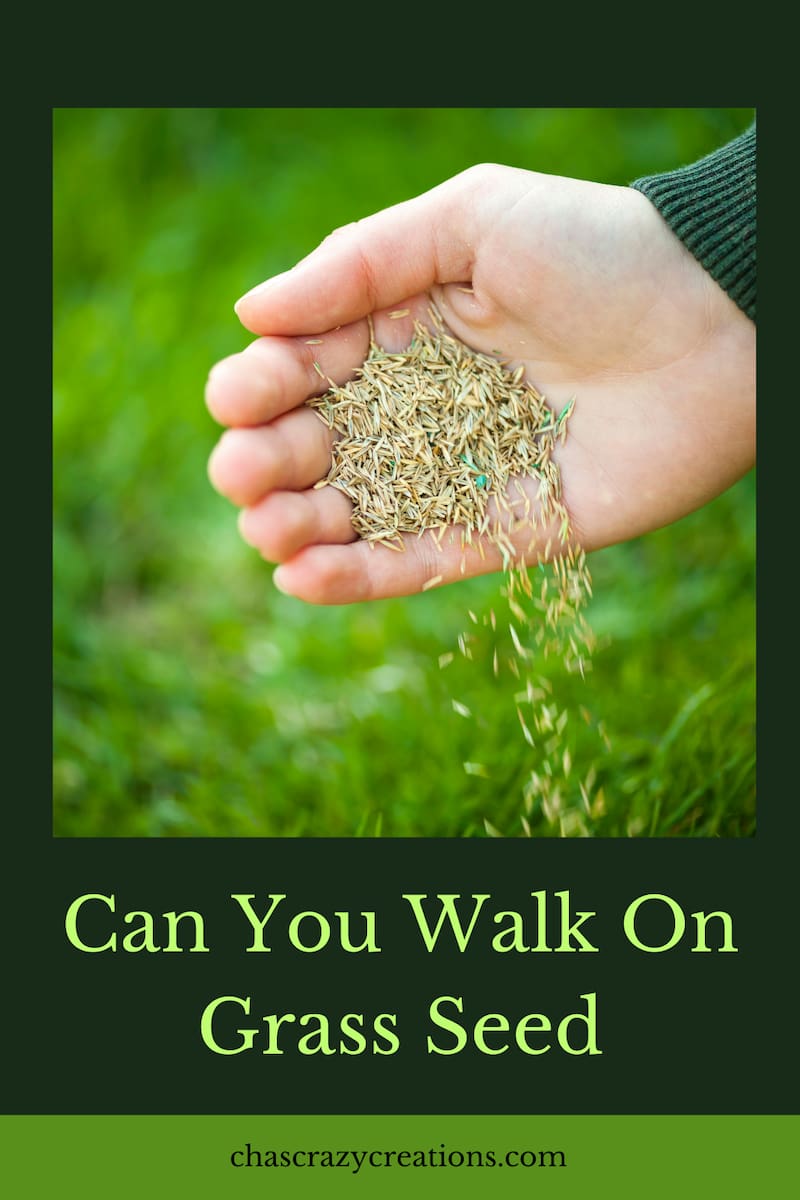Can You Walk On Grass Seed
Can you walk on grass seed? If you are planning to rejuvenate your lawn with fresh grass seed and you’re unsure of how foot traffic might affect the process, don’t be hasty! Setting foot on it too soon could undo all of your hard work, and waste whatever cash you’ve invested in this transformation.
This post may contain affiliate links, I earn from qualifying purchases at no extra cost to you. Click here for my disclosure policy
How long before you can walk on newly planted grass? How long after seeding can I walk on grass?
So when exactly can you start enjoying your new lawn, and what else can you do to ensure it grows healthily and prolifically in the long term?

Understanding the Basics of Grass Seeding
Starting a lawn from seed is an affordable and effective way to establish a green outdoor space. This method requires some knowledge about the different types of seeds available, their germination times, and ideal planting conditions.
For instance, cool-season grasses like Kentucky bluegrass or ryegrass usually prosper in northern climates whereas warm-season varieties such as Bermudagrass thrive in southern regions.
Timing also plays a significant role. Most horticulture experts recommend sowing during early spring or fall when conditions are conducive for germination, meaning mild temperatures along with ample sunlight and moisture. So with adequate preparation and care, you can boost your chances of successful seeding immensely.
When to Walk and Not Walk on Newly Seeded Lawns
Walking or running over newly seeded spaces should ideally be avoided. Your weight might compact the soil, making it challenging for young sprouts to push through the surface. Now consider these essential pointers:
- Limit movement on your lawn in the first few weeks after seeding.
- Always water gently during this period so that you don’t wash away or disturb seeds.
- If there’s a need to cross your lawn, try laying down planks of wood to distribute your weight evenly.
These mindful practices can protect new seedlings from unnecessary pressure and interference. It might take several weeks before it’s safe enough to walk on without caution, so it’s also best to carry out any landscaping projects in one fell swoop, to avoid added disruption post-seeding.
The Effects of Foot Traffic on Fresh Grass Seeds
As tempting as it might be to walk on grass seed or try out your new lawn immediately, the recommendation is not to. New shoots are extremely delicate and can get damaged rather easily under any weight stress. Walking over fresh grass seeds could result in stunted growth, patchiness, and overall poor plant health due to reduced root development.
Consider these two main outcomes:
- Soil Compaction: Weight applied directly onto the soil smothers budding grass plants by leaving less space for roots to grow.
- Disturbance: Your footfalls can displace loosened topsoil that’s covering freshly sown seeds.
To accelerate germination rate and hardiness of young sprouts, a judicious use of liquid lawn fertilizer could prove effective, allowing you to walk on grass seed sooner rather than later. But always remember that moderation is key!
Steps for Proper Grass Seed Maintenance Post-Seeding Period
After you’ve patiently sown your grass seed, the real work begins. Nurturing a new lawn requires dedication and precision with subsequent watering, mowing habits, and fertilization techniques.
Here are some additional steps to ensure the health of your young lawn:
- Regular Watering: Consistently keep your lawn moist but not overly drenched.
- Mowing Strategy: Wait until grass reaches around three inches before mowing it for the first time. Never cut more than one-third of its length at once.
- Fertilizing Schedule: Apply starter fertilizer during seeding. A month after germination begins, use a balanced formula specific to lawn care.
Adhering to these practices diligently lets you safeguard against unnecessary walking on delicate new shoots and provide them the space they need to develop into mature blades resilient enough even for rambunctious playtime or alfresco picnics.
Keeping Your Lawn Healthy While Seeding: Top Gardening Tips
As you embark on your lawn’s transformation, striking the sweet spot between allowing germination and retaining a healthy, active yard can be tricky. Here are some guidelines for maintaining lawn health during the seeding phase:
- Use a Quality Seed Mixture: Diversified seed mixtures tend to be more resilient towards foot traffic and environmental fluctuations.
- Ensure Well-aerated Soil: This prevents soil compaction and assists in root development.
- Adopt Proper Watering Techniques: A light sprinkle instead of intense watering conserves topsoil integrity.
Lastly, it all circles back to patience. Rushing through this stage might cost you in terms of irregular growth patterns or uneven patches.
Shop any of these stores and I receive a small commission at no cost to you.
 Scotts EZ Seed Dog Spot Rep...Shop on Amazon
Scotts EZ Seed Dog Spot Rep...Shop on Amazon Pennington Smart Seed Sun a...Shop on Amazon
Pennington Smart Seed Sun a...Shop on Amazon SMARTLAWN PROFESSIONAL Real...Shop on Amazon
SMARTLAWN PROFESSIONAL Real...Shop on Amazon DearHouse Artificial Ivy Pr...Shop on Amazon
DearHouse Artificial Ivy Pr...Shop on Amazon
Can you walk on grass seed Q & A
How long should I water new grass seed a day?
When watering new grass seed, it’s important to keep the soil consistently moist but not overly saturated. Here’s a general guideline for watering new grass seed:
- Initial watering: Immediately after seeding, you should water the area thoroughly to help settle the soil and ensure good seed-to-soil contact. Use a gentle spray or mist setting to avoid displacing the seeds. Water until the top 1 to 2 inches of soil are moist.
- Daily watering: For the first few weeks, it’s crucial to keep the soil consistently moist to promote germination and healthy growth. Typically, you’ll need to water the seeded area lightly at least once or twice a day, depending on the weather conditions.
- Watering frequency: Water in the early morning and again in the late afternoon or early evening to maximize absorption and minimize evaporation.
- Watering amount: Apply enough water to keep the soil surface damp, but avoid excessive runoff or standing water. Aim to moisten the top 1 to 2 inches of soil with each watering.
- Gradual reduction: As the grass seed begins to germinate and establish roots, you can gradually reduce the frequency of watering while increasing the amount of water applied. This encourages the roots to grow deeper into the soil.
- Transition to regular watering: Once the new grass reaches a height of around 2 to 3 inches and shows signs of healthy growth, you can transition to a more typical lawn watering schedule. Water deeply and infrequently, providing about 1 inch of water per week, either through rainfall or irrigation.
Remember that these are general guidelines, and you should adjust them based on your specific climate, soil conditions, and the type of grass seed you’ve planted. Observing the grass’s growth and monitoring the moisture level of the soil will help you determine the appropriate watering routine.
Should I mow over new grass seed?
It is generally recommended to avoid mowing over new grass seed until it has established a strong root system and reached an appropriate height. Mowing too early can disrupt the germination process and damage the young seedlings.
Here are some guidelines regarding mowing new grass seed:
- Germination period: Allow the grass seed to germinate and establish a good root system before considering mowing. This period can vary depending on the type of grass seed you’ve planted but typically takes several weeks.
- Height consideration: Once the grass has reached a height of around 3 to 4 inches, you can consider mowing. However, it’s crucial to check the specific recommendations for the grass variety you’ve seeded, as different types of grass may have different optimal heights for mowing.
- Mowing height: When mowing for the first time after seeding, set your mower to the highest setting to avoid cutting the grass too short. Gradually reduce the mowing height over subsequent mowings, ensuring you don’t remove more than one-third of the grass blade at a time.
- Mower blade and soil conditions: Ensure that your mower blade is sharp and in good condition to achieve a clean cut. Also, make sure the soil is not overly wet, as mowing on soggy soil can compact it and damage the young grass.
- Mowing frequency: As the grass continues to grow, establish a regular mowing schedule based on the recommended mowing height for your specific grass type. This is typically once every 1-2 weeks during the active growing season.
Always be gentle when mowing new grass to avoid uprooting or damaging the seedlings. It’s important to prioritize the health and establishment of the young grass before regular mowing practices can be followed.
Does grass seed need to be buried?
Yes, grass seed needs to be properly buried or in contact with the soil to ensure successful germination and establishment. When the seed is buried in the soil, it has better access to moisture, nutrients, and a stable environment for growth. Additionally, contact with the soil helps anchor the seed and promotes root development.
Here are some guidelines for properly burying grass seed:
- Soil preparation: Before sowing grass seed, prepare the soil by removing any debris, rocks, or weeds. Loosen the soil to a depth of a few inches to create a favorable seedbed. You can use a rake or a garden tiller to accomplish this.
- Seed-to-soil contact: It’s crucial to achieve good seed-to-soil contact to improve germination rates. Spread the grass seed evenly over the prepared soil. Rake lightly or use a seed spreader to ensure the seeds are in contact with the soil surface.
- Covering the seeds: To help protect the seeds and keep them in place, lightly cover them with a thin layer of soil or other suitable materials like straw or compost. The covering should be no more than ¼ to ½ inch thick, as excessive covering can hinder germination.
- Watering: After sowing the grass seed, water the area thoroughly to moisten the soil. This helps to initiate the germination process and encourages the seed to make contact with the soil particles.
By burying the grass seed at an appropriate depth and ensuring good seed-to-soil contact, you provide the conditions necessary for successful germination and establishment. Following proper seeding and watering practices will give your grass seed the best chance of growing into a healthy lawn.
What alternatives are there to grass?
Here is a list of options you can consider using instead of grass for your yard:
- Native wildflower meadow
- Ground covers (e.g., clover, creeping thyme, sedum, ajuga)
- Xeriscaping with drought-tolerant plants
- Rock garden or rock landscaping
- Vegetable and herb gardens
- Perennial flower beds
- Mulched areas with decorative features (e.g., statues, birdbaths, stepping stones)
- Hardscaping with pavers, stones, or decking
- Artificial turf or synthetic grass
- Wood chips or bark mulch
- Ornamental grasses
- Moss garden
- Container gardens or raised beds
- Fern garden
- Shade garden with shade-tolerant plants
- Water feature or pond
- Zen or meditation garden with gravel or sand
- Succulent garden or rockery
- Edible landscape with fruit trees, berry bushes, and edible plants
- Ground bamboo or ground cover bamboo (in suitable climates)
These options provide a range of alternatives to traditional grass lawns, catering to various aesthetics, functions, and environmental considerations. Assess your yard’s specific characteristics, such as sunlight exposure, soil conditions, and intended use, to choose the most suitable option(s) for your needs.
What are the cons of grass?
While grass lawns have been a traditional choice for many homeowners, there are some drawbacks and challenges associated with maintaining them. Here are a few cons of grass lawns to consider:
- Water Requirements: Grass lawns typically require a significant amount of water to stay healthy and green, especially in hot and dry climates. This can result in high water bills and water conservation concerns, particularly during drought periods.
- Maintenance Demands: Grass lawns require regular maintenance to keep them looking their best. This includes mowing, edging, fertilizing (and organic fertilizer can add up in cost), aerating for healthy root growth, and dealing with weeds and pests. The time, effort, and equipment needed for these tasks can be demanding, especially for larger lawns.
- Chemical Use: Maintaining a pristine grass lawn often involves the use of herbicides, pesticides, and synthetic fertilizers. These chemicals can have environmental impacts, such as leaching into waterways or harming beneficial insects and wildlife. Some people may prefer more natural or organic lawn care practices.
- Limited Biodiversity: Grass lawns offer limited habitat and food sources for beneficial insects, birds, and wildlife compared to diverse plantings. They contribute to habitat loss for native species and reduce overall biodiversity in the landscape.
- Soil Erosion: In areas with slopes or heavy rainfall, grass lawns may be more susceptible to soil erosion compared to other ground cover options. This can lead to the loss of valuable topsoil and create runoff issues.
- High Cost: Maintaining a grass lawn can be expensive, considering the costs of watering (sprinklers and a hose), fertilizers (soil nutrients), pesticides, lawn care equipment (lawn mower and sharpening of mower blades), and regular maintenance. The larger the lawn, the higher the costs involved.
- Lack of Functionality: Grass lawns often serve primarily as aesthetic spaces, offering limited functionality beyond recreational activities. For homeowners seeking multipurpose outdoor areas, alternatives like hardscaping, native gardens, or vegetable gardens may be more appealing.
- If you have kids or pets, you’ll have to deal with the kid and pet traffic damage, plus the dead spots caused by urination that you’ll be planting grass seed to repair on a regular basis.
It’s important to note that some of these cons can be mitigated or reduced by employing sustainable lawn care practices, choosing appropriate grass species for your climate, and considering alternatives to traditional grass lawns that better suit your needs and environmental priorities.

The Bottom Line
In conclusion, remember that walking on newly seeded lawns is generally discouraged to protect delicate grass sprouts. As a rough rule of thumb, wait about six to eight weeks after seeding before regular foot traffic can resume.
Now that you know the best way forward, it’s just a case of starting your grass seeding escapades soon, so that you can get on with enjoying the resultant growth as quickly as possible.







